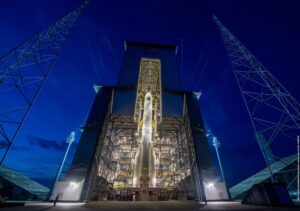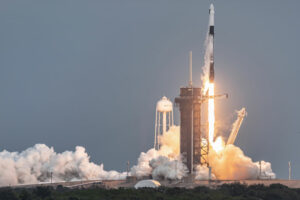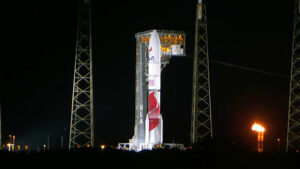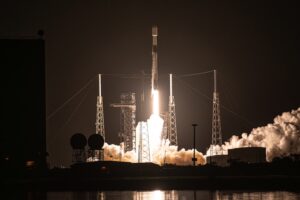
Forecasters on Friday predicted a 60% chance bad weather on Florida’s Space Coast could prevent the scheduled launch of a SpaceX Falcon 9 rocket early Saturday to begin an automated resupply mission to the International Space Station.
The official launch weather forecast, issued by the U.S. Space Force’s 45th Weather Squadron, predicts widespread cloud cover and scattered rain showers at NASA’s Kennedy Space Center during an instantaneous launch opportunity at 3:37 a.m. EDT (0737 GMT).
If weather cooperates, a 215-foot-tall (65-meter) Falcon 9 rocket will blast off from pad 39A at Kennedy, carrying a SpaceX Cargo Dragon capsule on a flight to the space station.
Earlier this week, SpaceX rolled the Falcon 9 launcher from its hangar out to pad 39A, then lifted the rocket vertical for final checkouts. SpaceX loaded the rocket with densified kerosene and liquid oxygen propellants for a 10-second test-firing of its Merlin 1D main engines at 9 p.m. EDT Wednesday (0100 GMT Thursday).
After completing the test-firing, SpaceX drained the rocket of propellant and started loading last-minute and time-sensitive cargo, such as fresh food and biological experiments, into the Cargo Dragon capsule using the access arm at pad 39A.
Once that work is complete, SpaceX teams will close the Dragon spacecraft’s hatch for flight and prepare for the start of the countdown Friday night.
SpaceX’s launch team inside Firing Room 4 at NASA’s Launch Control Center will oversee loading of liquid propellants into the Falcon 9 rocket beginning 35 minutes before liftoff time.
Propellant loading should be complete around T-minus 2 minutes as the Falcon 9 rocket’s on-board computer runs through an automated countdown sequence leading to ignition of the first stage’s nine Merlin engines.
After a quick computer-controlled engine health check, hold-down clamps will open to release the launcher.
The fully-loaded Falcon 9, weighing about 1.2 million pounds, will be propelled into the sky with 1.7 million pounds of thrust from its nine main engines.
But SpaceX and Space Force officials will be monitoring weather conditions during the countdown. There is a 60% probability that weather conditions could prevent launch, primarily due to concerns about the risk of lightning and rainfall in the Falcon 9 and Cargo Dragon’s flight path.

“Deep, tropical moisture is in place over the area along with persistent east/southeasterly flow due to high pressure centered off the coast of the Carolinas,” the Space Force weather team wrote in a forecast issued Friday. “This set-up favors onshore-moving coastal showers and isolated thunderstorms, especially in the overnight and morning hours.
“Tropical Storm Ida, currently centered just south of Cuba, is expected to move into the Gulf over the weekend,” forecasters wrote. “Although it will not directly impact east central Florida, it will usher in plentiful mid and upper level moisture over the Florida peninsula.
“Because of this and the scattered coastal showers, the primary concerns for the launch window on Saturday morning are the cumulus cloud rule, the flight through precipitation constraint, and the thick cloud layers rule.”
SpaceX has a backup launch opportunity at 3:14 a.m. EDT (0714 GMT) Sunday, when forecasters expect 40% chance conditions could prevent liftoff. The launch times are governed by the time when Earth’s rotation brings the launch pad under the space station’s orbital plane.
Assuming the weather is “go” for launch Saturday, the Falcon 9 will turn northeast to line up with the space station’s flight path. After exceeding the speed of sound, the Falcon 9 will streak through the stratosphere and release its reusable first stage about two-and-a-half minutes after liftoff.
The booster will make a controlled descent to SpaceX’s new floating rocket landing platform, named “A Shortfall Of Gravitas,” in the Atlantic Ocean about 180 miles (300 kilometers) northeast of Cape Canaveral.
It will be the first mission to use the new drone ship, which arrived in Florida last month from a shipyard in Louisiana. Landing on the deck of the drone ship is expected at T+plus 7 minutes, 38 seconds.
The Falcon 9 booster on Saturday’s flight, designated B1061, will attempt to make its fourth successful launch and landing. It previously launched NASA’s Crew-1 and Crew-2 missions carrying astronauts to the space station. Its third, and most recent, mission was on June 6 with the commercial SXM 8 radio broadcasting satellite.
While the first stage begins its descent, the Falcon 9’s second stage will ignite its Merlin engine at T+plus 2 minutes, 38 seconds, for a six-minute burn to accelerate the Cargo Dragon capsule into orbit.
The spacecraft is scheduled to deploy from the Falcon 9 upper stage at T+plus 11 minutes, 45 seconds.
The Cargo Dragon capsule, which previously flew on a resupply mission to the space station last December, will open its nose cone to reveal its docking mechanism a few minutes after separating from the Falcon 9 rocket.
A series of firings using the ship’s Draco thrusters will set up for a final approach to the space station Sunday.
An automated docking with the station’s Harmony module is scheduled at 11 a.m. EDT (1500 GMT) Sunday, delivering 4,866 pounds (2,207 kilograms) of supplies and experiments, including packaging.

Besides fresh food and spare parts, the Cargo Dragon is set to deliver an array of technology demonstration, materials science, and biomedical experiments to the space station.
They include a small robotic arm from GITAI Japan Inc., a Japanese company, to demonstrate in-space tasks that could lead to development of future robots to assist astronauts on long-duration space missions. The arm will run through its demonstrations, including switch and cable operations and in-space assembly experiments, inside the commercial Bishop airlock owned Nanoracks.
Some of the tasks will be autonomous, while others will be tele-operated from Nanoracks’ facility in Houston, according to GITAI.
“This technology demonstration is to show the world that the capabilities necessary for automation in space are finally available,” said Toyotaka Kozuki, GITAI Japan’s chief technology officer, in a statement. “It provides an inexpensive and safer source of labor in space, opening the door to the true commercialization of space.”
The mission also carries an experiment hosting package called the Faraday Research Facility. Developed by a Houston company named ProXops, the facility will be inserted by astronauts into one of the space station’s science racks.
On this flight, the facility carries an experiment from Houston Methodist Research Institute to test an implantable, remote-controlled drug delivery system. Scientists say the experiment could offer an alternative to bulky infusion pumps to help treat chronic conditions in patients on Earth.
NASA says facility also hosts two educational experiments to be performed on the space station, including one with participation from a Girl Scout troop on the ground.
There are also multiple CubeSats stowed inside the Cargo Dragon’s pressurized compartment. They will be robotically deployed outside the space station in the coming weeks and months.
The mission set for launch Saturday will be SpaceX’s 23rd commercial resupply flight to the space station since 2012, and the third to use a new generation of SpaceX Dragon cargo ships based on the company’s human-rated crew capsules.
NASA has multibillion-dollar contracts with SpaceX, Northrop Grumman, and Sierra Nevada Corp. to transport cargo to and from the space station.
Email the author.
Follow Stephen Clark on Twitter: @StephenClark1.
Source: https://spaceflightnow.com/2021/08/27/spacex-wrapping-up-final-cargo-load-for-launch-to-space-station/- "
- 11
- 7
- 9
- access
- AREA
- ARM
- around
- Automated
- Automation
- autonomous
- Backup
- capsules
- Cargo
- carrying
- Checks
- chief
- chief technology officer
- Cloud
- Column
- coming
- commercial
- company
- contracts
- Corp
- credit
- delivering
- delivery
- Development
- Dragon
- drone
- drug
- Early
- educational
- experiment
- Facility
- falcon
- Falcon 9
- Finally
- First
- flight
- florida
- flow
- food
- fresh
- Friday
- future
- Harmony
- Health
- High
- hosting
- HTTPS
- Impact
- Inc.
- Including
- infusion
- International
- international space station
- IT
- Japan
- labor
- launch
- lead
- leading
- Level
- lightning
- Line
- Liquid
- load
- Louisiana
- materials
- merlin
- million
- Mission
- model
- monitoring
- months
- move
- NEVADA
- nose
- ocean
- offer
- Officer
- official
- open
- Operations
- Opportunity
- Others
- Oxygen
- packaging
- patients
- platform
- pounds
- pressure
- pumps
- Radio
- research
- Risk
- robots
- Run
- satellite
- Science
- scientists
- Series
- set
- Share
- ships
- small
- South
- Space
- Space Force
- space station
- spacecraft
- SpaceX
- speed
- Stage
- start
- started
- Statement
- Storm
- stratosphere
- successful
- Switch
- system
- Technology
- test
- time
- transport
- treat
- tweet
- u.s.
- week
- weekend
- Work
- world







